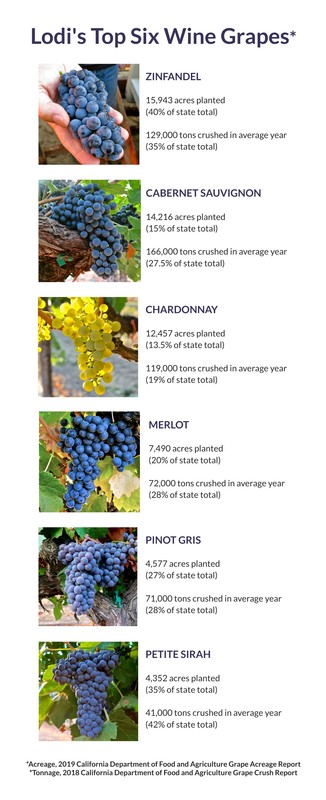Letters from Lodi
An insightful and objective look at viticulture and winemaking from the Lodi
Appellation and the growers and vintners behind these crafts. Told from the
perspective of multi-award winning wine journalist, Randy Caparoso.
Illustrated timeline of Lodi's grape history
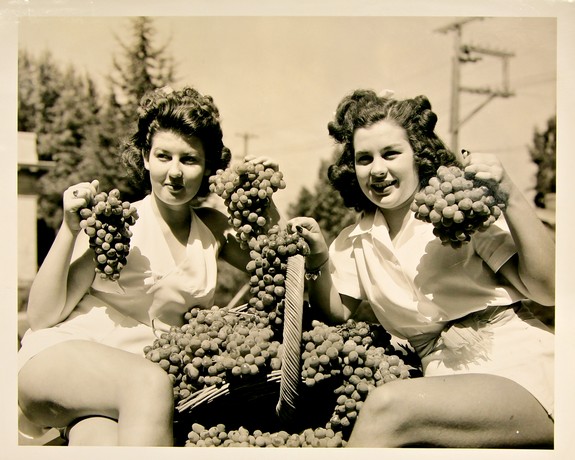
1941 Lodi Grape Festival Queens proudly showing off the region's reigning grape at the time, the legendary Flame Tokay.
This past week we were asked by the San Joaquin County Historical Society to summarize a history of Lodi appellation grapes at their yearly "Past, Present & Future" event... within five or ten minutes. Impossible, of course, but the thought process did give us a good excuse to draw up a 175-year timeline of this history.
This also gives us an opportunity to talk about the Museum operated by the San Joaquin County Historical Society, located in the historic 132-acre Micke Grove Park south of the City of Lodi. The park sits on a fraction of the original site of William G. Micke's 465-acre ranch, once planted to an astounding 400 acres of Flame Tokay (up until the 1970s, the most widely planted grape in Lodi).
Present-day visitors to Micke Grove Park can still see a small block of these magnificent, tree-like, head-trained vines, now over 100 years old, among towering valley oak trees. It's like walking through pre-statehood San Joaquin County (before the native oak groves were cleared) while brushing up against the nearly century-long era when Flame Tokay ruled Lodi's viticultural roost.
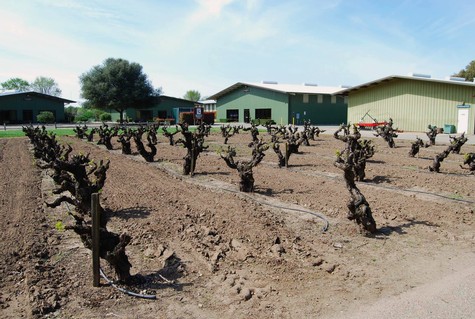
Remnant of William G. Micke's original 1922 block of Flame Tokay (now 101 years old!) at San Joquin HIstorical Society Museum.
The San Joaquin County Historical Society Museum consists of no less than eight buildings housing exhibits that tell the fascinating story of Lodi's agricultural history. Micke Grove, as the locals well know, is not just about trees and history, it also has the cutest little zoo, a gorgeous Japanese Garden, and even a kiddie-size amusement park that is just the right size (in other words, precluding miles and miles of "death" marching—excursions parents and kids know all too well). Bring a picnic lunch to enjoy the expansively shaded grounds and playground areas.
The timeline...
1848—Treaty of Guadalupe Hidalgo signed, ending the Mexican-American War and awarding California (and much of the present-day Western states from Utah to Texas) to the United States; meanwhile, gold is discovered in Sutter's Mill in the Sierra Nevada foothills, while a Swiss immigrant named Magley is said to have planted the first vineyard in the present-day area of Lodi, at a time when the entire landscape was still dominated by oak groves, grasslands, elk and grizzlies.
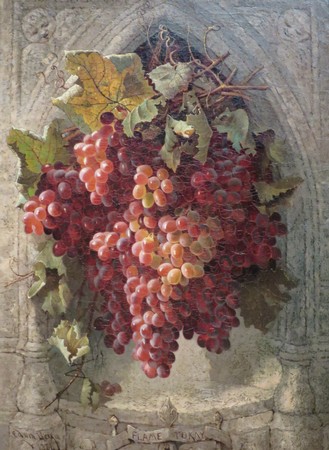
1884 grape catalog illustration of Flame Tokay by Edwin Deakin.
1850—California ratified as a state at a time when the territory is flooded by settlers; while in New England, nurseries were listing grapes such as Flame Tokay, Black Prince (now identified as Rose of Peru), "Zinfendel," "Zinfindal," "Black St. Peter's" (a possible synonym for Zinfandel) and dozens of other varieties of Vitis vinifera (i.e., European family of wine grapes) that would become popular in Lodi and the rest of California during the late 1800s.
1850—Captain Charles Weber, the "founder of Stockton" who had acquired a 49,000-acre Mexican land grant, plants a vineyard around his home for his personal usage.
1852—A Massachusetts entrepreneur named George West meets Captain Weber and is inspired to establish El Pinal Nursery and begin yearly shipments of plant material, beginning with 40 different grapes from Boston; including a variety called West's White Prolific (a.k.a., Colombard, at one time California's most widely planted wine grape) and Sultana (a precursor to Thompson Seedless, California's most widely planted grape, grown in the South Central Valley as a raisin and table grape crop and also still widely used for sparkling and table wine production).
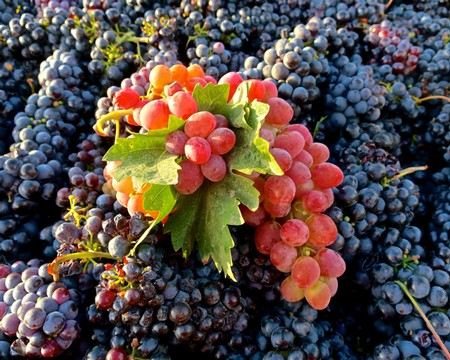
Flame Tokay and Zinfandel, are two grapes with an intertwining history—because they thrive in the same terroirs—traced as far back as the 1850s in both Lodi and Napa Valley.
1852—In the Oak Knoll area of Napa Valley, Joseph W. Osborne plants Zinfandel, Flame Tokay, and other grapes from plant material obtained through Frederick W. Moncondray, a Massachusetts sea captain and avid collector of plants primarily shipped over from Boston nurseries.
1857—Ezekial Lawrence (one of Lodi's founding fathers) arrives and makes note of the fact that there are less than 10 acres of vineyards in Lodi.
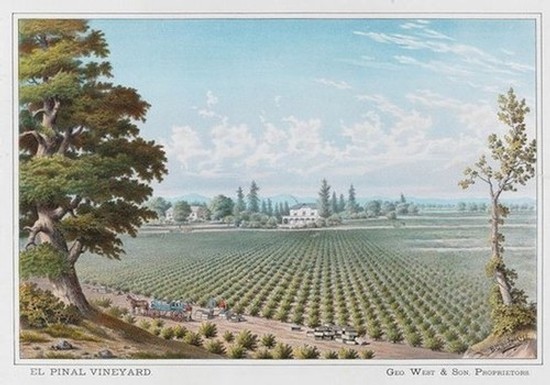
Late 1800s postcard illustration of El Pinal Vineyard, just north of Stockton along West Lane. Dr. Dean L. Mawdsley collection, California State Library.
1857—Flame Tokay (identified as Ahmeur Bou, a Vitis vinifera that originated in Algeria) is planted by James Rutter in the Florin area near Sacramento; the table grape is successfully sold in San Francisco fresh markets and, thereafter, is quickly embraced by growers in Lodi, who discover that the cultivar more easily attains its reddish-pink "flame" color in the rich sandy loam soils and cool summer nights moderating regions alongside the Delta.
1858—George West establishes El Pinal Winery in Stockton and begins contracting San Joaquin County farmers (primarily in the Lodi area) to plant grapes for his operation.
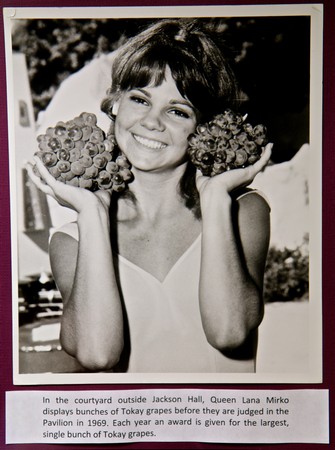
1969 Lodi Grape Festival Queen shows off the "queen" of Lodi's grape growing industry.
1861—In partnership with George West, George Perley plants 30 different grapes (including Flame Tokay).
1860s—A.T. Ayers plants Mission, a wine grape originally brought to California by Franciscans during the Mission era (1769 to 1833)
1864—George Leffler plants 6 acres of Flame Tokay, 2 acres of Black Prince, and more than a dozen other grapes in the vicinity of today's Eight Mile Road, between Lodi and Stockton.
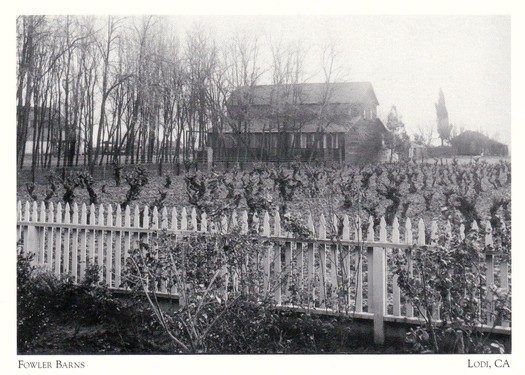
1907 postcard of Lodi-grown Flame Tokay grapevines, already at an advanced age.
1869—Lodi area business leaders persuade Central Pacific Railroad to establish a train depot on Sacramento Street just south of Pine Street, initiating formal planning of the City (still named Mokelumne at that time) and linking the region and its agricultural products to the entire country (the Transcontinental Railroad was also completed in 1869).
1869—A failed miner but successful mercantile merchant from Germany named Joseph Spenker establishes his square-mile Spenker Ranch near Woodbridge west of the City of Lodi and plants wheat (at the time, the largest wheat crop in the world was grown in San Joaquin County), rye, watermelon, and other seasonal crops.
1874—The name of the community of Mokelumne is changed to Lodi.
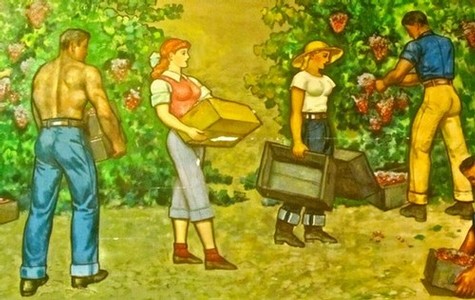
1960 mural by John Garth depicting the Lodi Flame Tokay harvest, Ole Mettler Pavillion, and Lodi Grape Festival.
1883—A Lodi-grown, Zinfandel-based red wine is submitted by El Pinal Winery to a viticultural convention in San Francisco.
1886—Anticipating the fall of watermelon prices (at the time, the Lodi area was known as the "Watermelon Capital of the Country"), Joseph Spenker consults with the West family at El Pinal Nursery and plants his first vineyard, 25 acres of "Black Malvoisie" (later identified as Cinsaut) which still exists today as Lodi's oldest surviving vineyard.
1888—Allen T. Covell purchases 160 acres just north of Turner Road near Woodbridge and plants large blocks of Flame Tokay and other grapes.
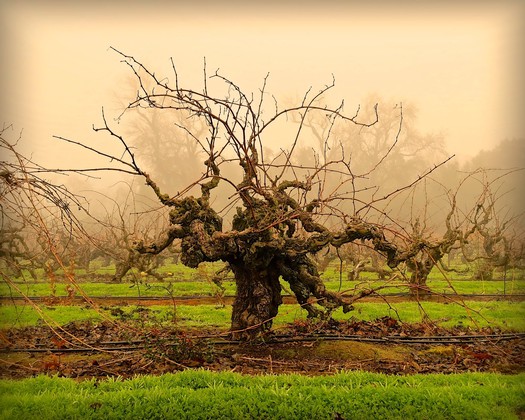
The robust health of this Flame Tokay grapevine, planted in 1889, can be directly attributed to the ideal terroir of Lodi's Mokelumne River appellation.
1889—Joseph Spenker commences planting of more blocks of grapes, continuing all the way through 1900; including Flame Tokay (22 acres), Zinfandel (16 acres), Mission (8 acres), Black Prince (7 acres), Carignan (5 acres) and a few others, some of which are still cultivated by Spenker's descendants today.
1890—El Pinal Winery has become renowned for its brandy, Port, Sherry as well as "Medoc" (table red wine made from black-skinned grapes native to Bordeaux, France), primarily made from Lodi-grown grapes.
1900—Germany-born entrepreneur Adolph Bauer establishes the first of two winery/grape receiving stations, starting with Urgon Winery, the site of present-day Lodi Vintners on Woodbridge Road, purchasing grapes at competitive prices (paying as much as $22/ton, compared to average $3.50/ton paid by the West family, reorganized as George West & Son Winery in 1899).
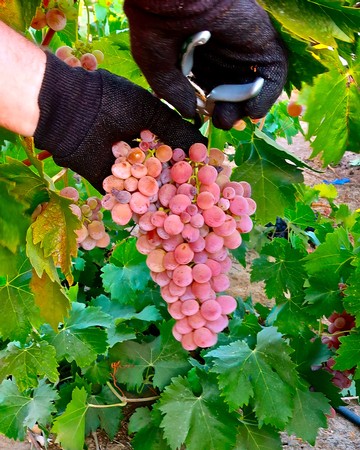
Recent harvesting of Flame Tokay from a Mokelumne River-Lodi blocks over 130 years old.
1903—George West & Son buys out Urgon Winery, and grape prices drop once more.
1905—Establishment of Woodbridge Vineyard Association, the first of many Lodi grower cooperatives to come, in direct response to low prices paid by the West family.
1906—the City of Lodi is incorporated, fast-tracking the development of municipal infrastructures while moving the community away from its "Wild West" lineage.
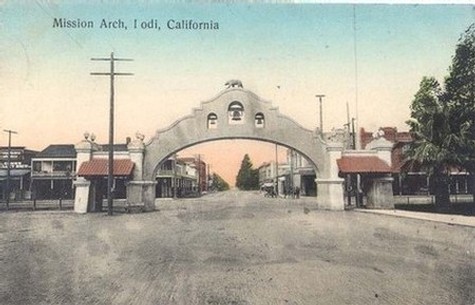
Colorized postcard of Lodi's historic Mission Arch, a few years after it was erected for the 1907 Tokay Carnival, a three-day festival celebrating the newly established City (in 1906) and its hugely successful Flame Tokay grape industry.
1907—To celebrate and publicize the wealth brought to the region by Flame Tokay, supplying more than half of the table grapes grown in California, the City of Lodi holds a three-day Tokay Carnival (September 19-21) presided over by a duly elected "Queen Zinfandel" and a court of 10 ladies in waiting, opening with a mile-long procession of horse-drawn carts teeming with grapes, and ending at 8:00 PM on the final night when the Queen "abdicated" her throne to a "King Tokay" who ordered all watches and clocks set back 6 hours and the arrest of anyone found partying on the streets without a mask.
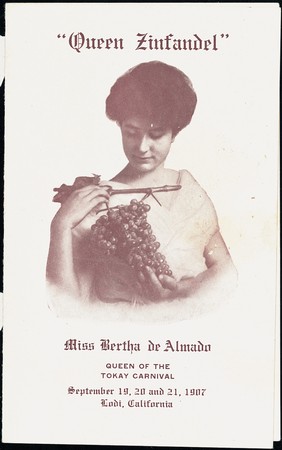
1907 postcard of Tokay Carnival's "Queen Zinfandel"—a 20-year-old Lodi beauty named Bertha de Almado—with, of course, a cluster of Flame Tokay, the region's signature grape and primary economic driver.
1919—The Volstead Act (a.k.a., National Prohibition Act) outlaws sales of alcoholic beverages but includes Section 29 which allows family units to produce up to 200 gallons (equivalent to a thousand bottles) a year of their own wine, thus creating a huge demand for wine grapes leading to increased vineyard acreage and rapid expansion of Lodi's grape packing industry.
1923—Cesare and Rosa Mondavi arrive in Lodi from Minnesota to establish the C. Mondavi & Sons wholesale fruit company; later, all four children attend Stanford University, and Robert and Peter Mondavi operate Charles Krug Winery in Napa Valley (1943) while their parents remain in Lodi.
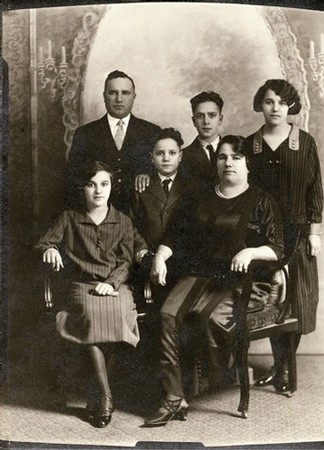
Mid-1920s photo of the Mondavi family in Lodi: Cesare and Rosa with children Mary, Helen, Robert, and Peter
1933—When the Volstead Act is repealed, grape prices drop drastically as the market is flooded, leading to the establishment of numerous other grower cooperatives; including Cherokee Vineyard Association (purchased by Robert Mondavi in 1979, becoming Woodbridge Winery), East Side Winery (current site of Oak Ridge Winery), Woodbridge Vineyard Association (reactivated in Sacramento County, then moved to Turner Road in 1947, two facilities now owned by E. & J. Gallo), Guild Winery & Distilleries (during the 1960s, the largest winery in the world), and Lodi Winery (formerly Urgon Winery, now the site of Lodi Vintners).
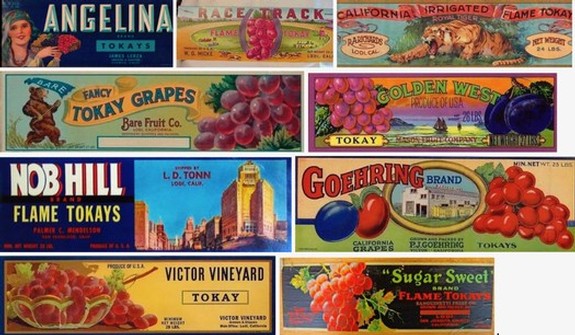
A sampling of colorful Flame Tokay labels—glued to wood crates packed with 26 pounds of fruit—employed by Lodi packing companies.
1943—In an address to the Lodi Rotary Club, James M. Prentice marked the ongoing dominance of Flame Tokay in the Lodi grape industry, saying: "There are now approximately 1,040 Tokay vineyards in the Lodi District owned by 1,013 growers... the entire tonnage of the Lodi District will equal 275,000 tons for 1943 with a roadside valuation of $25 million [adjusted for inflation, equal to $439 million today]."
1969—For the first time in U.S. history, Americans drink more table wine than fortified dessert wines, spelling the beginning of an end for the cooperative business model dominating the Lodi wine industry, specializing in dessert wines and brandy rather than "fine" table wines (particularly varietals such as Cabernet Sauvignon or Chenin Blanc) for which coastal wine regions became known.
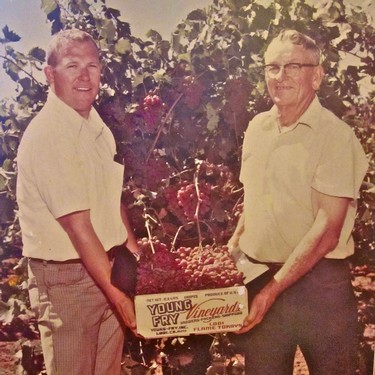
Late 1960s photo of Jerry Fry (left) of Mohr-Fry Ranches, a leading Flame Tokay grower at the time.
1973—Flame Seedless (Sultana x Cardinal) grape crossing is developed in Fresno; one of many varieties of seedless table grapes bred to thrive in warmer climate regions in South Central Valley, spelling the beginning of an end for the nearly century-long dominance of Flame Tokay in the Lodi region and economy.
1975—Borra Vineyards founded by Steve Borra, the first of the small, handcraft, homegrown grower/family wineries representing Lodi's modern era; followed by other successful operations such as The Lucas Winery (1978), Phillips Winery (1984, later changed to Michael David Winery).
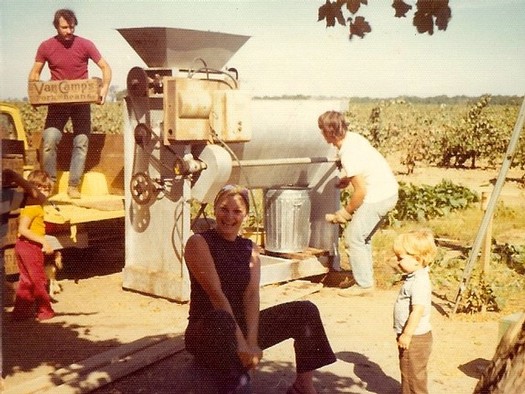
Steve Borra (left) and his wife Beverly during their earliest years as pioneer Lodi handcraft wine producers.
1976—An internationally publicized "Judgement of Paris" tasting in France draws attention to the high quality of California Cabernet Sauvignon and Chardonnay, leading to dramatic changes in the economic landscape of wine regions such as Napa Valley and Sonoma County, and eventually an explosion of wine grape expansion into the Lodi wine region (particularly to meet the demand of large, value wine producers no longer able to source suitable grapes from coastal regions).
1991—Lodi (a.k.a., USDA District 11) grape growers establish the Lodi Winegrape Commission, a self-taxing organization aimed at bolstering grape sales, viticultural education, and awareness of the increasing quality of Lodi-grown grapes and wines; eventually leading to the expansion of Lodi's wine grape acreage to over 100,000 acres by 2010 (from about 46,000 acres in the mid-1990s), easily the largest in the United States!
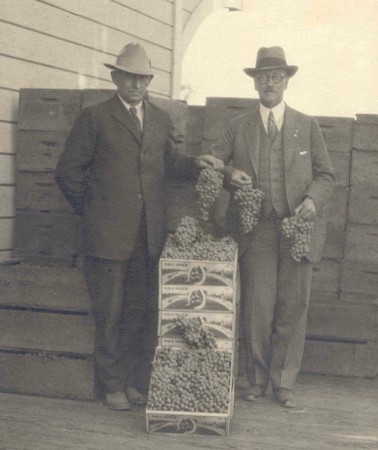
William G. Micke (right) showing off the impeccable quality of his Flame Tokay grown in his 400-acre vineyard and packed under his famed "Race Track" label.
2023—While Flame Tokay has all but disappeared, Zinfandel remains Lodi's most widely planted grape (approximately 40% of the state's entire production) by dint of its natural suitability to the region's Mediterranean climate and sandy soils; Lodi now commercially grows over 125 wine grape varieties, while supplying much of the American wine industry's growing needs for grapes such as Cabernet Sauvignon, Chardonnay, Sauvignon blanc, Pinot Gris and Petite Sirah.
